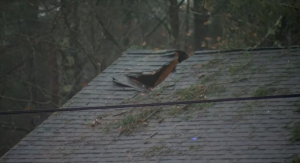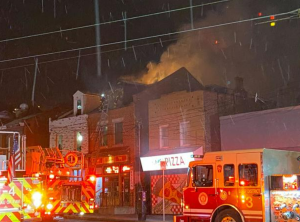
By Tracy Loew
David Blunck studied the spread of wildfires in depth for many years.
He said that his academic work became more personal after a wildfire hit his parent’s home in Canby in September of 2020.
Blunck was an associate professor at Oregon State University of Mechanical Engineering. He knew that danger didn’t come from the wall of fire engulfing a home. The danger was from windblown firebrands. They can fly up to one mile in the air and start new fires.
The experience was eye-opening, he added. I am more motivated to convey to the general public that each of us must take individual responsibility for protecting ourselves and our homes in the event of a wildfire, especially on the more environmentally friendly side of Oregon.
Blunck’s research into wildfires revealed
Blunck’s OSU team tests the impact of variables, such as tree species, temperature and wind speed on how firebrands are formed and spread.
He explained that “firebrands” can play a major role in the spread of some fires.
Researchers have used a wind tunnel of a smaller scale to investigate the growth of flames on different types of dowels.
The researchers’ groundbreaking work has been done on the ground, when they have burned and counted hundreds of cut trees.
Blunck noted that “we gained insights as to which species give out more cold firebrands or hot firebrands. We also found the average number of firebrands produced by each tree.”
Interestingly, the researchers discovered that larger trees emit fewer firebrands when they normalize them by their mass.
Researchers found that average firebrand heat fluxes for Douglas firs and sagebrushes with short needles were an order higher than those produced by ponderosas with long needles.
Blunck says that now the results of this research can be used as inputs to models which predict fire behavior.
The Joint Fire Science Program and National Institute of Standards and Technology of the United States government funded the project.
Blunck’s next goal is to find out how the firebrands originate and spread in structures. He is now applying for funding so he can repeat the experiment with sheds and not trees.
Use research to improve firebrands
Blunck was able to walk around the home of his parents during wildfires in 2020, protecting them from flames. All homeowners should follow Blunck’s example.
It would be “a great, big step” if people would ask themselves, as they walk through their homes, whether a lit match, or even a cigarette, would cause a spark. Then, he would eliminate this risk.
This could include removing bark or other flammable materials from near a home, replacing them with gravel and keeping the leaves and needles out of gutters or roofs.
He says that screens are helpful for windows.
This screen is useful to keep out firebrands if the window in your house breaks.
The perforated screen on soffits can help to improve air circulation in the attic.
“These are all things which reduce the threat of homes,” he stated. Although they may not be able to control the event, they are still able to influence the outcome for a building or home.
Home fire safety: Reduce your risk!
Firewise USA teaches group of homeowners about how to plan emergency escapes, make sure that there is enough space around the home, decrease combustibles fuels and create defensible spaces.
Here are a few additional tips that can help reduce fire risks in the home.
Home hardening – Home hardening is the process of making your home structure more resistant to spreading fire. Modifications and the use of materials resistant to flames and heat are necessary to protect your home from ember intrusion. Important aspects of hardening your home include:
Roofing and siding materials: For roofing and siding choose fire-resistant material such as asphalt, metal tiles or tile with a class A fire rating.
To prevent the entry of embers, install windows made from tempered glasses and cover vent covers with ember resistant vent covers.
Avoid ember accumulation by using non-combustible materials on eaves, soffits and roofs.
Decks and fences – Consider using fire-resistant decking material and creating a space that can be used to defend the area beneath your deck. Fences should be made of metal or materials that are non-combustible.
Doors: Opt for fire-resistant exterior doors, including garage doors.
Defensible Space and Fuel Reduction: In order to create defensible spaces around your home, it is necessary to reduce or remove flammable material and vegetation which could be used for fueling wildfires. Fires are prevented from reaching your property and the area is safe for firefighters. Key practices for creating defensible space include:
Zone 0: Use only non-combustible material like stone or gravel within five feet of your house. Get rid of leaves, debris or flammable vegetation.
Zone 1 – Extend the perimeter 30 feet out from the residence, while reducing the amount of flammable foliage, trimming trees, and spacing the plants. This will prevent the fire from spreading to the crowns.
Zone 2 – Extend the trees 100 feet away from your home. Make sure they are well pruned and widely separated.
Zone 3: extend 200 feet away from your home. Maintain healthy space between the trees. Remove dead vegetation.
To make informed decisions about roofing, it is crucial to understand your options. Roof shingles form a crucial part of the aesthetics and protection for your home.
Discover the many styles and varieties of roof shingles. Asphalt, wooden, metal, or tile are a few of the many options available. All offer their own unique features in terms durability, price, and aesthetics. These options will help you to choose the shingles best suited for your preferences and needs.
It’s advisable to consult a roofing specialist before replacing or installing your professional roof shingles. Experts can give you advice on what type of shingle is best for your particular climate, budget and aesthetic preferences. They will also offer advice about proper maintenance and roof repairs in order to increase the life of your roof.
To ensure your home’s longevity and protection, it is essential to prioritise the health and condition of the roof at https://universalroofs.ca/. Consult with roofing experts to make the best decisions, regardless of whether you want to plan a roof project or address an issue.





